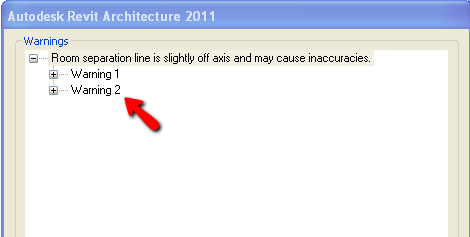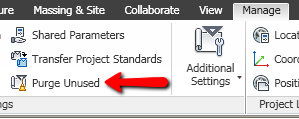Revit Chapter 10 Quizlet Ags Cannot Be Edited in the Family Editor

When working full steam for a deadline, it is easy to overlook some of the warnings Revit produces. If left unchecked for too long, yous tin can amass 700, 800 or even 1000 warnings—which can make your model dull and cumbersome, because it keeps looking to run into if the "problems" have been stock-still. Take a moment to check how many yous have in the model and the "quality" of those warnings. The almost common, benign and easiest to set up are warnings virtually rooms separation lines overlapping each other or walls and warnings saying that 2 items have the same type marking. More complicated warnings like ramp slope and stair riser warnings should get reviewed right abroad, because they crave more circuitous calculations and can have a bigger affect on functioning.



Revit is capable of modeling many complicated things AND make them parametric (changeable). Yes, you can model every widget in that complicated piece of equipment, but should you? The answer is near likely no. If you go along the mantra of "Keep It Uncomplicated" and merely model what yous need/when you need it, you lot will wind upwardly with a smaller, easier to employ model. Beware of items that come up from RevitCity or manufacturers, as they typically are modeled with a lot of detail.

Revit is amazing when it comes to creating views. You can create sections, elevations and 3D views with the blink of an eye. This is swell, however, an excessive amount of views—especially 3D perspective or isometric views—can weigh a model down. Once you're done using the section you lot cut to quickly check something, make certain to delete it. Try keeping the philosophy of "proper name it or delete it" when information technology comes to views to continue your model in check equally yous go.

This ways roofs, floors, ceilings, filled regions, ramps, stairs and whatsoever other particular that put y'all into pink lined sketch mode. Complicated sketches using a lot of splines require Revit to process more data. This doesn't mean nosotros shouldn't blueprint wild curvy ceilings, it but means we should proceed an eye on how that ceiling is impacting the file.

Don't be a hoarder when it comes to Revit families in your model. Keeping a pocket-size collection of items you are sure you'll need in the time to come is ok, only keeping every slice of casework y'all loaded but in case y'all need it someday is not. If a component you lot need accidentally gets purged, information technology can always be loaded back in.


When you create important things like grids or levels, the tendency is to want to lock them. Locking components to other components causes Revit to review the locked human relationship every fourth dimension you lot alter one of the items you lot've locked. When you have a lot of items locked, Revit has a lot of reviewing to do. Also, if i of your grids or special items gets moved out of position, yous run the risk of moving all of your grids if they're locked together, catastrophically damaging your model instead of just having 1 grid out of identify. Try using locks but when you're building families in the family editor.

Groups e'er seem similar a great idea at offset, but they wind up operation differently than you expect them to. Use groups sparingly and with skilful reason. If it seems similar your group could be fabricated into a static family unit, it probably should be. Also, be wary of the types of components you're grouping together. Wall hosted items like sinks or doors tin can have issues when they're grouped abroad from their host (the wall), or in with non-wall hosted items like sinks or casework.

This is a huge source of file size and model performance problems in Revit. If yous admittedly must bring CAD into a Revit model, always relieve a copy of the file first and clean out the riff raff. Delete whatever elements that somehow snuck off into no human's land, purge the file, run the "overkill" control and audit it. Brand sure when yous type in "Z E" for zoom extents that your drawing is centered on the screen.
When you bring the CAD in, always link it instead of embedding it. That mode, you lot can find the file when you lot need to alter it, reload information technology or remove it. Embedded CAD has the knack of getting lost in your views. Sometimes it tin get hidden and become difficult to find.
Images are virtually a separate issue. When imported into the model, an image will maintain its original size even if yous scale it downwardly in the view. If yous find yourself scaling the view down quite a scrap, unlink it and cut down the image size prior to loading information technology into the model. Go along only the images you really need in the model and delete the rest using the manage images tab.


These should be used very sparingly, if at all. Modeling in an outside family is actually easier than using the family editor. Also, when you copy an in-identify family unit, it makes another family. Before you know it you could have Special Casework 1 ,ii, iii, … 25…. But use an in-place family unit if it's something you can't model outside of the projection in the family unit editor.

Once you are washed using a design option, delete information technology. When there are a big amount of design options in the model, Revit has to think near how each pick influences the objects around it. The more yous have, the more thinking that occurs and the slower your model.
OTHER WAYS TO Assistance:
1. Saving to Central using the "Open – Save Page"
This is a simple legend view that volition assistance your model open up faster. Synchronizing with a 3D view open, especially one that has shadows on, will take a long fourth dimension to open side by side time y'all want to access the file. (NOTE: If y'all are using Revit 2012, it has a tool under the manage tab that allows you lot to designate which view you want Revit to open the file with. Your Open Save Page or another small view should be selected for this task. While you're at that place, make sure to check out the Revit All-time Practices department that Jason Grant wrote. There is a lot of valuable information in there.)
2. Auditing once or twice a calendar week
Checking this box will give you a warning that it will take a long time. However, I've never seen it take much longer than the usual load time. If you are always having issues with your file crashing or behaving strangely, try auditing information technology and see if that helps. Often times it will.
3. Compacting the file at the end of the day
It really isn't much slower than your normal save to central and tin assist keep your file trim and efficient.
4. Over writing the model with a fresh copy
This should be done past an experienced Revit user on an equally needed footing. It volition assistance clean upwardly older back up and temp files, which volition make the file size smaller.
5. Put linked models on their own workset
If linked models are on their own workset, you can choose non to load them. That volition save you lot time opening and saving the model.
This post was inspired past Steve Stafford of Revit Op Ed'southward Article "File Size – A Cherry-red Herring?" and recent sessions with MyCadd.
Source: https://payette.com/technology/ten-ways-to-keep-your-revit-model-speedy/